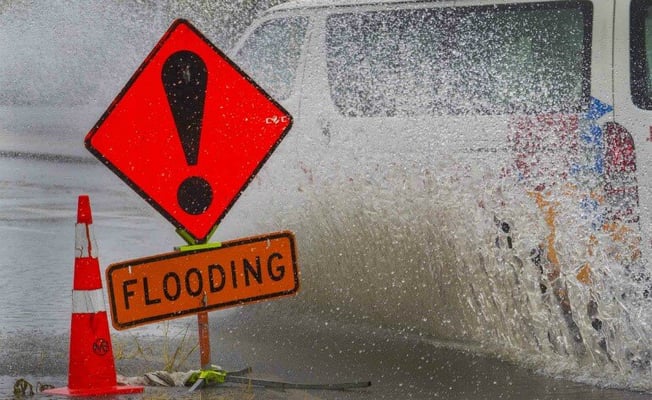Ex-tropical cyclone Gita passes NZ, leaving destruction in its wake

States of local emergency have been terminated in Westland, Buller, Grey and Selwyn Districts, and in Christchurch City after ex-tropical cyclone passed through the east coast of the South Island on Wednesday morning.
Though for the Nelson-Tasman region and New Plymouth district, it was still in place until Wednesday night. The authorities had declared the state of emergency in seven regions on Tuesday anticipating the devastation that ex-cyclone Gita was expected to bring to the South Island of the country.
Announcing this on Wednesday after the morning high tide passed with no major flooding issues in the city, Christchurch Mayor Lianne Dalziel noted, “I felt it was important to make the initial declaration because the worst of the storm was expected to hit overnight. I was concerned that people could be struggling to deal with flooding in the dark. We were lucky this time.”
This is so as Christchurch appeared to have escaped the worst of ex-Tropical Cyclone Gita after the cyclone split and tracked further south than predicted. The rainfall in the city was half the forecast figure. Fortunately, there was little wind. Some of the eastern bays on the Banks Peninsula did receive higher rainfall and wind though. There was also flooding around the city and signage was placed at 28 sites.
Overall, the ex-tropical cyclone brought heavy rain affecting parts of the country on Tuesday, and early morning Wednesday. Meanwhile, eastern Otago was still seeing persistent rain with some heavy falls on Wednesday afternoon.
|
Greatest rainfall totals: (midnight Monday into Tuesday, through to 3 p.m. Wednesday) Hundalee Ranges south of Kaikoura: 296.5 mm Motueka: 133.6 mm Hurunui: 132.0 mm Arthur’s Pass: 130.4 mm |
Many places recorded greater than their average monthly rainfall for February – in the space of just a day or two. Notably, Kelburn station in Wellington has recorded its total historical average rainfall for February in 24 hours. Maximum wind gusts were recorded over the Buller and Taranaki region; with Westport and Hawera also facing gusts of 118km/h and 130km/h respectively.
There were thousands of power outages as well. This included 1400 homes in the Taranaki region, 300 homes in the Pukerua Bay, and more than 2000 properties in Manawatu, Rangitikei and Whanganui.

The storm has also affected flights, with operations in Christchurch, Wellington and Nelson's airports suspended at several durations during Tuesday and Wednesday.
Stretches of State Highway (SH) 1 along the east coast of South Island were also closed due to flooding and downed trees, especially affecting access to Kaikoura. It was re-established with SH 70 via Waipara and Waiau reopening on Wednesday morning. A home just south of the Kaikoura town was damaged after gravel and floodwaters filled it on Tuesday night.
 (Picture: NZ Herald)
(Picture: NZ Herald)
More than 40 schools across South Island were closed anticipating the ex-tropical cyclone's arrival on Tuesday. Many of those remain closed on Wednesday.
The damage at the West Coast was less than expected, as the region is still recovering from ex-cyclone Fehi and king tides of February 1.
SH 6 closed overnight Tuesday but reopened on Wednesday. It meant that more than 100 tourists were stranded around Westland.
In Golden Bay, north of Nelson, about 6000 residents are still isolated because the Takaka Hill road (SH 60) has turned into a river due to 16 slips resulting in two sections of the road is completely washed away.
Repairs will take few days and essential supplies are being taken to the Golden Bay by boat as SH 60 is the only route to the region.
With Gita now past its shores, the civil defence teams across the affected areas have shifted their focus to recovery mode.
 (Picture: Star Kiwi Reporter)
(Picture: Star Kiwi Reporter)
Civil Defence Minister Kris Faafoi and Damien O’Connor, MP for West Coast Tasman, also travelled to the South Island on Wednesday to see the effects of former Cyclone Gita and discuss recovery with local mayors and officials.
“We are assessing the damage across affected regions. The focus will be on the clean up and recovery, doing damage assessment and supporting communities and travellers who are isolated or affected. There was considerable damage over the past 24 hours, good decisions were made to declare local states of emergency early. The Ministry of Civil Defence and Emergency management is also keeping an eye on the potential for more heavy rain in South Canterbury and Otago, and the effect of this on river levels,” the Minister said, after his visit.
States of local emergency have been terminated in Westland, Buller, Grey and Selwyn Districts, and in Christchurch City after ex-tropical cyclone passed through the east coast of the South Island on Wednesday morning.
Though for the Nelson-Tasman region and New Plymouth district, it was still in...
States of local emergency have been terminated in Westland, Buller, Grey and Selwyn Districts, and in Christchurch City after ex-tropical cyclone passed through the east coast of the South Island on Wednesday morning.
Though for the Nelson-Tasman region and New Plymouth district, it was still in place until Wednesday night. The authorities had declared the state of emergency in seven regions on Tuesday anticipating the devastation that ex-cyclone Gita was expected to bring to the South Island of the country.
Announcing this on Wednesday after the morning high tide passed with no major flooding issues in the city, Christchurch Mayor Lianne Dalziel noted, “I felt it was important to make the initial declaration because the worst of the storm was expected to hit overnight. I was concerned that people could be struggling to deal with flooding in the dark. We were lucky this time.”
This is so as Christchurch appeared to have escaped the worst of ex-Tropical Cyclone Gita after the cyclone split and tracked further south than predicted. The rainfall in the city was half the forecast figure. Fortunately, there was little wind. Some of the eastern bays on the Banks Peninsula did receive higher rainfall and wind though. There was also flooding around the city and signage was placed at 28 sites.
Overall, the ex-tropical cyclone brought heavy rain affecting parts of the country on Tuesday, and early morning Wednesday. Meanwhile, eastern Otago was still seeing persistent rain with some heavy falls on Wednesday afternoon.
|
Greatest rainfall totals: (midnight Monday into Tuesday, through to 3 p.m. Wednesday) Hundalee Ranges south of Kaikoura: 296.5 mm Motueka: 133.6 mm Hurunui: 132.0 mm Arthur’s Pass: 130.4 mm |
Many places recorded greater than their average monthly rainfall for February – in the space of just a day or two. Notably, Kelburn station in Wellington has recorded its total historical average rainfall for February in 24 hours. Maximum wind gusts were recorded over the Buller and Taranaki region; with Westport and Hawera also facing gusts of 118km/h and 130km/h respectively.
There were thousands of power outages as well. This included 1400 homes in the Taranaki region, 300 homes in the Pukerua Bay, and more than 2000 properties in Manawatu, Rangitikei and Whanganui.

The storm has also affected flights, with operations in Christchurch, Wellington and Nelson's airports suspended at several durations during Tuesday and Wednesday.
Stretches of State Highway (SH) 1 along the east coast of South Island were also closed due to flooding and downed trees, especially affecting access to Kaikoura. It was re-established with SH 70 via Waipara and Waiau reopening on Wednesday morning. A home just south of the Kaikoura town was damaged after gravel and floodwaters filled it on Tuesday night.
 (Picture: NZ Herald)
(Picture: NZ Herald)
More than 40 schools across South Island were closed anticipating the ex-tropical cyclone's arrival on Tuesday. Many of those remain closed on Wednesday.
The damage at the West Coast was less than expected, as the region is still recovering from ex-cyclone Fehi and king tides of February 1.
SH 6 closed overnight Tuesday but reopened on Wednesday. It meant that more than 100 tourists were stranded around Westland.
In Golden Bay, north of Nelson, about 6000 residents are still isolated because the Takaka Hill road (SH 60) has turned into a river due to 16 slips resulting in two sections of the road is completely washed away.
Repairs will take few days and essential supplies are being taken to the Golden Bay by boat as SH 60 is the only route to the region.
With Gita now past its shores, the civil defence teams across the affected areas have shifted their focus to recovery mode.
 (Picture: Star Kiwi Reporter)
(Picture: Star Kiwi Reporter)
Civil Defence Minister Kris Faafoi and Damien O’Connor, MP for West Coast Tasman, also travelled to the South Island on Wednesday to see the effects of former Cyclone Gita and discuss recovery with local mayors and officials.
“We are assessing the damage across affected regions. The focus will be on the clean up and recovery, doing damage assessment and supporting communities and travellers who are isolated or affected. There was considerable damage over the past 24 hours, good decisions were made to declare local states of emergency early. The Ministry of Civil Defence and Emergency management is also keeping an eye on the potential for more heavy rain in South Canterbury and Otago, and the effect of this on river levels,” the Minister said, after his visit.









Leave a Comment